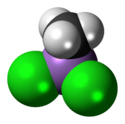Methyldichloroarsine
| |||
| Names | |||
|---|---|---|---|
| Preferred IUPAC name
Methylarsonous dichloride | |||
| Identifiers | |||
3D model (
JSmol ) |
|||
| Abbreviations | MD MDA | ||
| ChemSpider | |||
| MeSH | Methyldichloroarsine | ||
PubChem CID
|
|||
CompTox Dashboard (EPA)
|
|||
| |||
| |||
| Properties | |||
| CH3AsCl2 | |||
| Molar mass | 160.86 g·mol−1 | ||
| Appearance | Colorless liquid | ||
| Density | 1.836 g/cm3 | ||
| Melting point | −55 °C (−67 °F; 218 K) | ||
| Boiling point | 133 °C (271 °F; 406 K) | ||
| reacts | |||
| Hazards | |||
| Occupational safety and health (OHS/OSH): | |||
Main hazards
|
Highly toxic, Irritant | ||
Except where otherwise noted, data are given for materials in their standard state (at 25 °C [77 °F], 100 kPa).
| |||
Methyldichloroarsine, sometimes abbreviated "MD" and also known as methyl Dick,
History
German chemists weaponized methyldichloroarsine during
Structure, synthesis, reactivity
Focusing on the arsenic center, the molecule geometry is trigonal pyramidal with the Cl-As-Cl and C-As-Cl angles approaching 90° (see image). Virtually all related arsenic(III) compounds adopt similar structures.
Methyldichloroarsine is produced by the reaction of methylmagnesium chloride and arsenic trichloride:[3]
- AsCl3 + CH3MgCl → CH3AsCl2 + MgCl2
Typically such syntheses are conducted in ether or
In World War I, the German manufacturing method consisted of a three-step reaction beginning with methylation of sodium arsenite:
- 2 Na3AsO3 + (CH3O)2SO2 → 2 CH3AsO(ONa)2 + Na2SO4,
followed by reduction of the disodium monomethylarsonate with sulfur dioxide:
- CH3AsO(ONa)2 + SO2 → CH3AsO + Na2SO4,
subsequently reacting the monomethylarsine oxide thus formed with hydrogen chloride to yield methyldichloroarsine:[4]
- CH3AsO + 2 HCl → CH3AsCl2 + H2O
The As-Cl bonds in MD are susceptible toward
Use as a weapon
Symptoms of poisoning
Although some of its symptoms resemble those from
MD is not persistent, meaning that it will dissipate after a short time.
Protection
Besides avoiding situations in which it might be used, an
See also
References
- PMID 18015982.
- ^ a b c Fitzgerald GM, Vollmer T (2006-06-19). "CBRNE - Vesicants, Organic Arsenicals: L, ED, MD, PD, HL". WebMD. Retrieved 2008-12-23.
- ^ ISBN 9781411694323.
- ^ Lohs KH (1974). Synthetische Gifte (in German) (4th ed.). Berlin (East), GDR: Militärverlag der Deutschen Demokratischen Republik.
- ^ ISBN 9781420052664.


